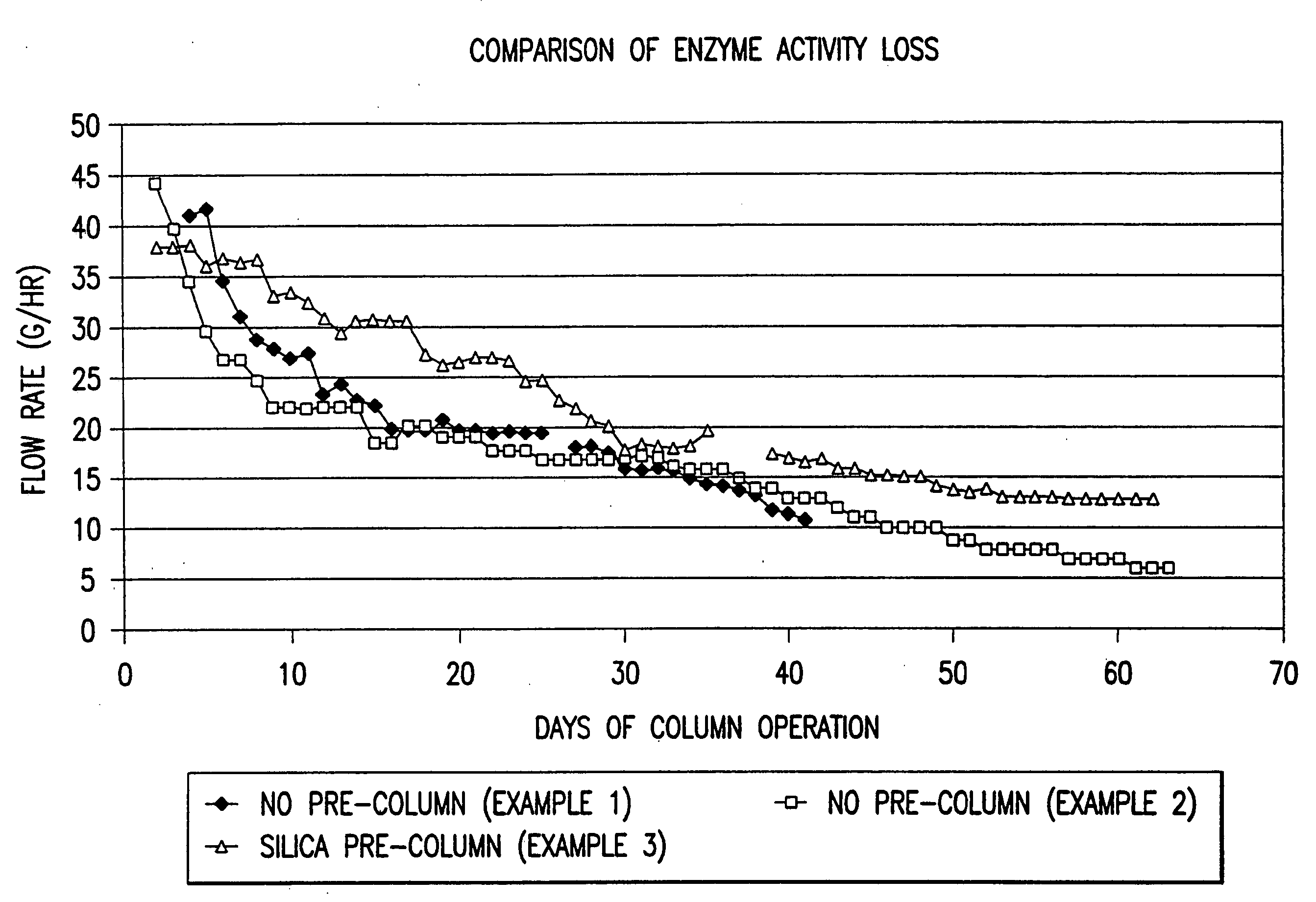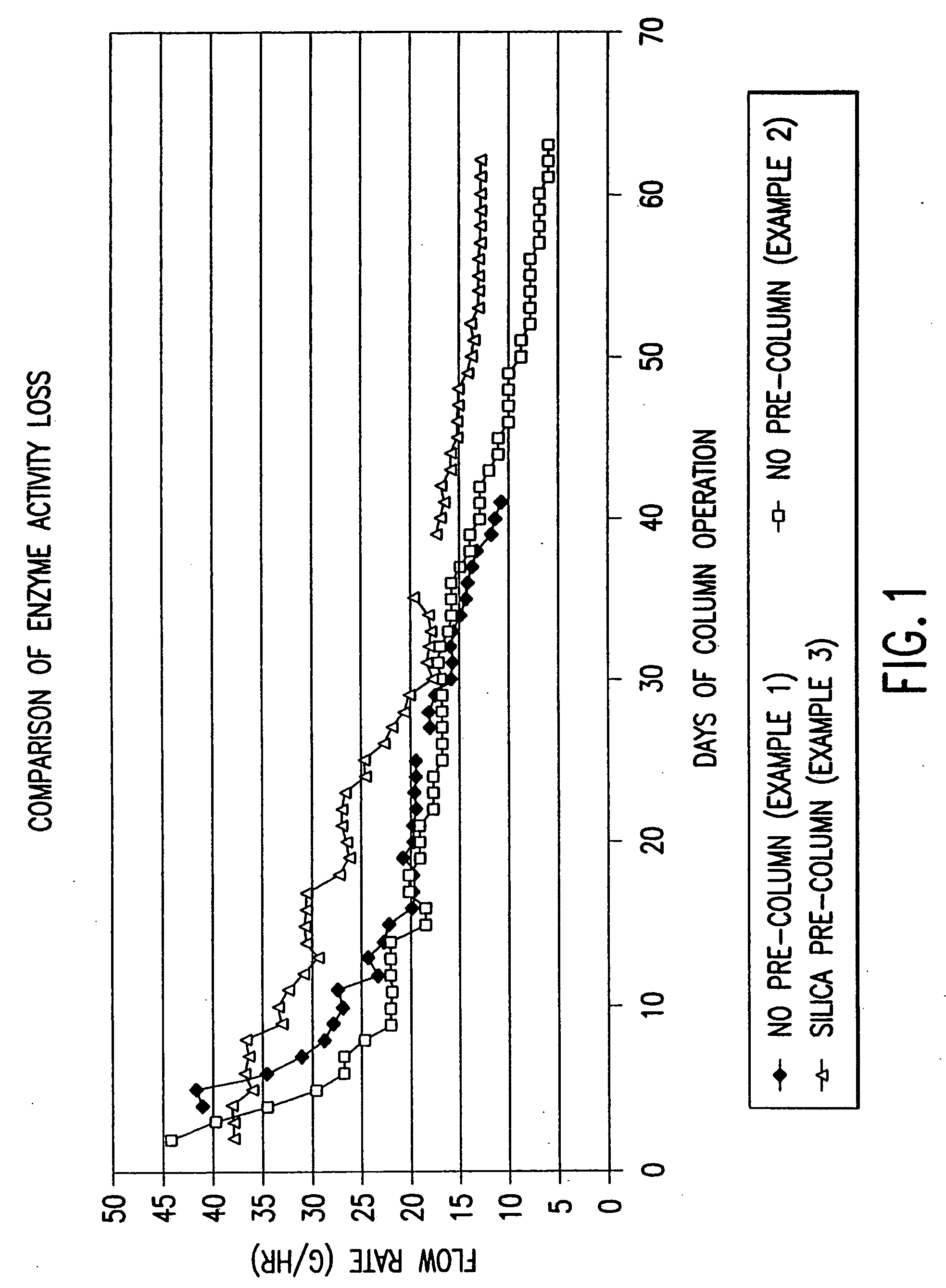Method for producing fats or oils
a technology of fats and oils, applied in the field of methods for producing fats and oils, can solve the problems of non-specific chemical transesterification or chemical esterification, high temperature, wasteful by-product generation, etc., and achieve the effect of prolonging the half-life of enzymes
- Summary
- Abstract
- Description
- Claims
- Application Information
AI Technical Summary
Benefits of technology
Problems solved by technology
Method used
Image
Examples
example 1
22 g of enzyme (Novozymes' Lipozyme® TL IM) was mixed with liquid soybean oil and packed into a jacketed glass column (2.7-cm diameter). The soy oil was flushed out by pumping the actual substrate (fully hydrogenated soy oil:liquid soy oil=27:73). The column and the substrate were maintained at 65° C. Extent of enzyme reaction could be monitored very well by the change of melting properties of the substrate and products, which was measured as Mettler dropping point (MDP). Oil flow of the column was adjusted so as to have the products' MDP at 117-118° F. Enzyme activity was calculated by comparing the flow rates at which the products have similar MDPs near 117-118° F.
Table 1 summarizes the results. There was a quick activity drop for the first 2 weeks; then the activity drop slowed down. The enzyme activity at Day 13 was about 60% level of that at Day 4. There was another quick activity drop after Day 30. FIG. 1 (closed diamonds) shows the data in greater detail.
TABLE 1Summary R...
example 2
An enzyme column was prepared and run in the same way as described in Example 1, except using a peristaltic pump instead of a piston pump, for replication. Table 2 summarizes the results. As in Example 1, there was a quick activity drop for the first 2 weeks; then, the activity drop slowed down. However, there was another quick activity drop after Day 35. FIG. 1 (open squares) shows the data in greater detail.
TABLE 2Summary Results of the Column Operation WithoutSilica Pretreatment as in Example 2˜Day 2:Flushing out soy oil & flow rate adjustmentDay 2˜Day 8:44% activity drop in 6 days (7-day half-life estimation)Day 2˜Day 12:49% drop in 10 days (10-day half-life estimation)Day 12˜Day 35:28% drop in 23 days (40-day half-life estimation)Day 35˜Day 46:37% drop in 11 days (15-day half-life estimation)Day 45˜Day 51:18% drop in 6 days (16-day half-life estimation)
example 3
An enzyme column was prepared as described in Example 1 and 2, and 38 g of silica gel (35-60 mesh, 60 Å) was placed on top of the enzyme bed. Conditions for column operation and analysis were the same as in the previous examples. Table 3 summarizes the results.
There was no quick activity drop in the beginning of the column operation, and the half-life estimation at the time was about 30 days. Even longer half-life estimation was observed as the column was operating for an extended period. FIG. 1 (open triangles) shows the data in greater detail.
TABLE 3Summary Results of the Column Operation withSilica Pre-Column Treatment˜Day 2:Flushing out soy oil & flow rate adjustmentDay 2˜Day 9:13% activity drop in 7 days (28-day half-lifeestimation)Day 9˜Day 34:46% drop in 25 days (27-day half-life estimation)Day 34˜Day 46:15% drop in 12 days (41-day half-life estimation)Day 45˜Day 60:15% drop in 15 days (50-day half-life estimation)
PUM
| Property | Measurement | Unit |
|---|---|---|
| pressure | aaaaa | aaaaa |
| pressure | aaaaa | aaaaa |
| holding time | aaaaa | aaaaa |
Abstract
Description
Claims
Application Information
 Login to View More
Login to View More - R&D
- Intellectual Property
- Life Sciences
- Materials
- Tech Scout
- Unparalleled Data Quality
- Higher Quality Content
- 60% Fewer Hallucinations
Browse by: Latest US Patents, China's latest patents, Technical Efficacy Thesaurus, Application Domain, Technology Topic, Popular Technical Reports.
© 2025 PatSnap. All rights reserved.Legal|Privacy policy|Modern Slavery Act Transparency Statement|Sitemap|About US| Contact US: help@patsnap.com


